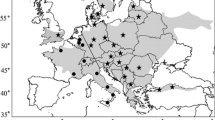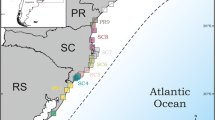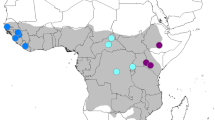Abstract
The funnel-web spider genus Macrothele is the only representative of the mygalomorph family Hexathelidae not found in Australia or New Zealand. Its 26 species occur in Central Africa and the Oriental region. Two Macrothele species are found in Europe: M. cretica Kulczynski, 1903 from Crete, and M. calpeiana (Walckenaer, 1805) type species of the genus and the largest European spider, whose distribution extends across the south-eastern Iberian Peninsula, and in two localities of North Africa. Macrothele calpeiana is the only spider protected under European legislation. The fragmentation and destruction of the cork oak forest, with which M. calpeiana was thought to be closely associated, prompted the inclusion of this species in the Bern Convention. Some authors, however, have challenged this view and consider M. calpeiana to be neither a cork oak forest bioindicator nor an endangered species. By contrast, other observations suggest that the distribution of the species is extremely fragmented and that most local populations should be considered as threatened. In this paper, we examine aspects of the conservation status of M. calpeiana in the light of molecular phylogenetic analyses based on mitochondrial markers of sample specimens from major populations. Our data confirm the fragmented distribution of M. calpeiana and reveal high levels of genetic differentiation across its populations. Local population growth cannot be ruled out, though the lineage as a whole has apparently not undergone population growth. Lineage age estimates suggest that M. calpeiana colonized the Iberian Peninsula during the Messinian salinity crisis and that the current population fragmentation originates from the Pliocene and Pleistocene. We argue that the fragmentation and deep genetic divergence across populations, along with evolutionary singularity and endemicity in one of Europe’s main biodiversity hotspots, support the preservation of its legally protected status.



Similar content being viewed by others
References
Arntzen JW, García-París M (1995) Morphological and allozyme studies of midwife toads (genus Alytes) including the description of two new taxa from Spain. Contrib Zool 65:5–34
Avise JC (2000) Phylogeography: the history and formation of species. Harvard University Press, Cambridge, Mass
Ballard JW, Whitlock MC (2004) The incomplete natural history of mitochondria. Mol Ecol 13:729–744
Barea-Azcón JM, Ferrández MA, Ballesteros-Duperón E, Irurita JM (2005) Factores ambientales condicionantes de la distribución de Macrothele calpeiana (Walkenaer, 1805) a nivel de macrohábitat: implicaciones para su conservación. In: VI Jornadas del Grupo Ibérico de Aracnología. http://www.aracnologia.ennor.org/docs/actas_GIA_2005.pdf, Madrid
Blasco A, Ferrández MA (1986) El género Macrothele Ausserer, 1871 (Araneae: Dipluridae) en la Península Ibérica. In: X International Congress of Arachnology, Jaca, Spain, pp 311–320
Blondel J, Aronson J (1999) Biology and wildlife of the Mediterranean region. Oxford University Press, Oxford, New York
Bond JE (2004) Systematics of the Californian euctenizine spider genus Apomastus (Araneae : Mygalomorphae : Cyrtaucheniidae): the relationship between molecular and morphological taxonomy. Invertebr Syst 18:361–376
Bond JE, Beamer DA, Lamb T, Hedin M (2006) Combining genetic and geospatial analyses to infer population extinction in mygalomorph spiders endemic to the Los Angeles region. Anim Conserv 9:145–157
Bond JE, Hedin MC, Ramirez MG, Opell BD (2001) Deep molecular divergence in the absence of morphological and ecological change in the Californian coastal dune endemic trapdoor spider Aptostichus simus. Mol Ecol 10:899–910
Brandley MC, Schmitz A, Reeder TW (2005) Partitioned Bayesian analyses, partition choice, and the phylogenetic relationships of Scincid lizards. Syst Biol 54:373–390
Bremer K (1994) Branch support and tree stability. Cladistics 10:295–304
Brower AVZ (1994) Rapid morphological radiation and convergence among races of the butterfly Heliconius erato inferred from patterns of mitochondrial DNA evolution. Proc Natl Acad Sci USA 91:6491–6495
Calvo-Hernández D, Santos-Lobatón MC (2001) Variabilidad morfológica de las poblaciones de Macrothele calpeiana (Walckenaer, 1805) (Araneae, Hexathelidae) en la provincia de Cádiz (España). Rev iber Aracnol 3:43–45
Carranza S, Arnold EN (2003) History of West Mediterranean newts, Pleurodeles (Amphibia: Salamandridae), inferred from old and recent DNA sequences. Syst Biodivers 1:327–338
Carranza S, Wade E (2004) Taxonomic revision of Algero-Tunisian Pleurodeles (Caudata: Salamandridae) using molecular and morphological data. Revalidation of the taxon Pleurodeles nebulosus (Guichenot, 1850). Zootaxa 488:1–24
Collins NM, Wells S (1987) Invertebrates in need of special protection in Europe. Augier H. Nature & Environment Series No. 35. Council of Europe, Strasbourg, pp 162
Corzo G, Escoubas P (2003) Pharmacologically active spider peptide toxins. Cell Mol Life Sci 60:2409–2426
Crandall K, Bininda-Emonds O, Mace G, Wayne R (2000) Considering evolutionary processes in conservation biology. Trends Ecol Evol 15:290–295
Drummond AJ, Rambaut A (2003) BEAST. Available from http://www.evolve.zoo.ox.ac.uk/beast/
Duggen S, Hoernle K, van den Bogaard P, Rüpke L, Morgan JP (2003) Deep roots of the Messinian salinity crisis. Nature 422:602–606
Dupanloup I, Schneider S, Excoffier L (2002) A simulated annealing approach to define the genetic structure of populations. Mol Ecol 11:2571–2582
Emerson B, Paradis E, Thebaud C (2001) Revealing the demographic histories of species using DNA sequences. Trends Ecol Evol 16:707–716
Emerson BC, Oromi P, Hewitt GM (2000) Colonization and diversification of the species Brachyderes rugatus (Coleoptera) on the Canary Islands: evidence from mitochondrial DNA COII gene sequences. Evolution 54:911–923
Farris JS, Albert VA, Kallersjo M, Lipscomb D, Kluge AG (1996) Parsimony jackknifing outperforms neighbor-joining. Cladistics 12:99–124
Ferrández MA, Ferrández de Céspedes H (1996) Macrothele calpeiana. In: Inventario de los invertebrados incluidos en los Anejos de la directiva 92/43/CEE del Consejo. Icona, Madrid
Ferrández MA, Ferrández de Céspedes H (2001) Arachnida. In: Ramos MA, Bragado D, Fernández J (eds) Los Invertebrados no insectos de la “Directiva Hábitat” en España, Ministerio de Medio Ambiente, Dirección Genaral de la Conservación de la naturaleza, pp 133–144
Ferrández MA, Ferrández de Céspedes H, Perucho A (1998) Macrothele calpeiana, la araña negra de los alcornocales. Quercus 146:14–18
Foelix RF (1996) Biology of spiders. Oxford University Press, New York
Funk DJ, Omland KE (2003) Species-level paraphyly and polyphyly: frequency, causes, and consequences, with insights from animal mitochondrial DNA. Annu Rev Ecol Evol Syst 34:397–423
Gallon RC (1994) Observations on Macrothele calpeiana (Walckenaer, 1805) in southern Iberia. J Br Tarantula Soc 1:1–12
Gantenbein B, Largiader CR (2003) The phylogeographic importance of the Strait of Gibraltar as a gene flow barrier in terrestrial arthropods: a case study with the scorpion Buthus occitanus as model organism. Mol Phylogenet Evol 28:119–130
García-París M, Alcobendas P, Alberch P (1998) Influence of the Guadalquivir River basin on mitochondrial DNA evolution of Salamandra salamandra (Caudata: Salamandridae) from Southern Spain. Copeia 1:173–176
Giribet G, Wheeler W, Muona J (2002) DNA multiple sequence alignments. In: DeSalle R, Giribet G, Wheeler W (eds) Molecular systematics and evolution: theory and practice. Birkhaüser Verlag, Switzerland, pp 107–114
Goloboff PA, Farris JS, Nixon KC (2003) TNT: tree analysis using new technologies
Gómez A, Lunt DH (2004) Refugia within refugia: patterns of phylogeographic concordance in the Iberian Peninsula. In: Weiss S, Ferrand N (eds) Phylogeography in Southern European refugia: evolutionary perspectives on the origins and conservation of European biodiversity. Kluwer Academic Publishers, Dordrecht
Gómez-Zurita J, Petitpierre E, Juan C (2000) Nested cladistic analysis, phylogeography and speciation in the Timarcha goettingensis complex (Coleoptera, Chrysomelidae). Mol Ecol 9:557–570
Gutiérrez Larena B, Fuertes Aguilar J, Nieto Feliner G (2002) Glacial-induced altitudinal migrations in Armeria (Plumbaginaceae) inferred from patterns of chloroplast DNA haplotype sharing. Mol Ecol 11:1965–1974
Hafernik JEJ (1992) Threats to invertebrate biodiversity: implications for conservation strategies. In: Fiedler PL, Jain SK (eds) Conservation biology: the theory and practice of nature conservation, preservation, and management. Chapman and Hall, New York and London, pp 171–195
Harpending HC, Batzer MA, Gurven M, Jorde LB, Rogers AR, Sherry ST (1998) Genetic traces of ancient demography. Proc Natl Acad Sci USA 95:1961–1967
Harris DJ, Batista V, Carretero MA (2004) Assessment of genetic diversity within Acanthodactylus erythrurus (Reptilia: Lacertidae) in Morocco and the Iberian Peninsula using mitochondrial DNA sequence data. Amphibia–Reptilia 25:227–232
Hedin M, Bond JE (2006) Molecular phylogenetics of the spider infraorder Mygalomorphae using nuclear rRNA genes (18S and 28S): conflict and agreement with the current system of classification. Mol Phylogenet Evol 41:454–471
Hedin MC (1997) Molecular phylogenetics at the population/species interface in cave spiders of the Southern Appalachians (Araneae: Nesticidae: Nesticus). Mol Biol Evol 14:309–324
Hendrixson BE, Bond JE (2005) Testing species boundaries in the Antrodiaetus unicolor complex (Araneae: Mygalomorphae: Antrodiaetidae): “paraphyly” and cryptic diversity. Mol Phylogenet Evol 36:405–416
Hewitt G (1999) Post-glacial recolonization of European biota. Biol J Linn Soc 68:87–112
Hewitt G (2000) The genetic legacy of the quaternary ice ages. Nature 405:907–913
Hewitt G (2001) Speciation, hybrid zones and phylogeography—or seeing genes in space and time. Mol Ecol 10:537–549
Hung S-W, Wang T-L (2004) Arachnid envenomation in Taiwan. Ann Disast Med 3:S12–S17
Irwin DE (2002) Phylogeographic breaks without geographic barriers to gene flow. Evol Int J Org Evol 56:2383–2394
Kass RE, Raftery AE (1995) Bayes factors. J Am Stat Assoc 90:773–795
Krijgsman W, Hilgen FJ, Raffi I, Sierro FJ, Wilson DS (1999) Chronology, causes and progression of the Messinian salinity crisis. Nature 400:652–655
Kumar S, Tamura K, Nei M (2004) MEGA3: integrated software for molecular evolutionary genetics analysis and sequence alignment. Brief Bioinform 5:150–163
Kuo C, Avise J (2005) Phylogeographic breaks in low-dispersal species: the emergence of concordance across gene trees. Genetica 124:179–186
Lin CP, Danforth BN (2004) How do insect nuclear and mitochondrial gene substitution patterns differ? Insights from Bayesian analyses of combined datasets. Mol Phylogenet Evol 30:686–702
Lucas H (1839) Arachnides, myriapodes et thysanoures. In: Barker-Webb, Berthelod S (eds) Histoire naturelle des îles Canaries, II, 2e partie: Zoologie. Paris, pp 19–52
Martínez-Solano I, Goncalves HA, Arntzen JW, Garcia-Paris M (2004) Phylogenetic relationships and biogeography of midwife toads (Discoglossidae: Alytes). J Biogeogr 31:603–618
Medail F, Quezel P (1997) Hot-spots analysis for conservation of plant biodiversity in the Mediterranean Basin. Ann MO Bot Gard 84:112–127
Medail F, Quezel P (1999) Biodiversity hotspots in the Mediterranean basin: setting global conservation priorities. Conserv Biol 13:1510–1513
Mickevich MF, Farris JS (1981) The implications of incongruence in Menidia. Syst Zool 30:351–370
Moore WS (1995) Inferring phylogenies from mtDNA variation: Mitochondrial-gene trees versus nuclear-gene trees. Evolution 49:718–726
Moritz C (1994) Defining ‘evolutionarily significant units’ for conservation. Trends Ecol Evol 9:373–375
Myers N, Mittermeier RA, Mittermeier CC, da Fonseca GA, Kent J (2000) Biodiversity hotspots for conservation priorities. Nature 403:853–858
Nylander JAA, Ronquist F, Huelsenbeck JP, Nieves-Aldrey JL (2004) Bayesian phylogenetic analysis of combined data. Syst Biol 53:47–67
Palmer M, Cambefort Y (2000) Evidence for reticulate palaeogeography: beetle diversity linked to connection–disjunction cycles of the Gibraltar strait. J Biogeogr 27:403–416
Perry L (2002) Captive breeding of funnelweb spider Macrothele calpeiana (Walckenaer, 1805). J Br Tarantula Soc 17:113–121
Platnick NI (2005) The world spider catalog. American Museum of Natural History, online at http://www.research.amnh.org/entomology/spiders/catalog81–87/INTRO1.html, New York
Posada D, Crandall KA (1998) MODELTEST: testing the model of DNA substitution. Bioinformatics 14:817–818
Prager EM, Wilson AC (1988) Ancient origin of lactalbumin from lysozyme: analysis of DNA and amino acid sequences. J Mol Evol 27:326–335
Rambaut A, Drummond AJ (2003) TRACER. Available from http://www.evolve.zoo.ox.ac.uk/tracer/
Rapoport EH (1982) Areography: geographical strategies of species. Pergamon Press, Oxford
Raven RJ (1980) The evolution and biogeography of the mygalomorph spider family Hexathelidae (Araneae, Chelicerata). J Arachnol 8:251–266
Ribera I (2000) Biogeography and conservation of Iberian water beetles. Biol Conserv 92:131–150
Roest WR, Srivastava SP (1991) Kinematics of the plate boundaries between Eurasia, Iberia, and Africa in the North Atlantic from the Late Cretaceous to the present. Geology 19:613–616
Ronquist F, Huelsenbeck JP, van der Mark P (2005) MyBayes 3.1 manual. online at http://www.mrbayes.csit.fsu.edu/wiki/index.php/Manual
Ryder O (1986) Species conservation and systematics: the dilemma of subspecies. Trends Ecol Evol 1:9–10
Sanger F, Nicklen S, Coulsen AR (1977) DNA sequencing with chain terminating inhibitors. Proc Natl Acad Sci USA 74:5463–5468
Sanz de Galdeano CM (1996) Tertiary tectonic framework of the Iberian peninsula. In: Friend PF, Dabrio CJ (eds) Tertiary basins of Spain. Cambridge University Press, Cambridge, pp 9–14
Scheller J, Guhrs K-H, Grosse F, Conrad U (2001) Production of spider silk proteins in tobacco and potato. Nat Biotechnol 19:573–577
Schneider S, Excoffier L (1999) Estimation of past demographic parameters from the distribution of pairwise differences when the mutation rates vary among sites: application to human mitochondrial DNA. Genetics 152:1079–1089
Selden PA, Shear WA, Bonamo PM (1991) A spider and other arachnids from the Devonian of New York, and reinterpretations of Devonian Araneae. Palaeontology 34:241–281
Shear WA, Palmer JM, Coddington JA, Bonamo PM (1989) A Devonian spinneret: early evidence of spiders and silk use. Science 246:479–481
Shimodaira H, Hasegawa M (1999) Multiple comparisons of log-likelihoods with applications to phylogenetic inference. Mol Biol Evol 16:1114–1116
Simmons MP, Ochoterena H (2000) Gaps as characters in sequence-based phylogenetic analyses. Syst Biol 49:369–381
Simon C, Frati F, Beckenbach A, Crespi B, Liu H, Flook P (1994) Evolution, weighting, and phylogenetic utility of mitochondrial gene sequences and a compilation of conserved polymerase chain reaction primers. Ann Entomol Soc Am 87:651–701
Snazell RG (1986) The spider genus Macrothele Ausserer in Spain (Araneae, Dipluridae). Bull Br Arachnol Soc 17:80–83
Snazell RG, Allison R (1989) The genus Macrothele Ausserer (Araneae; Hexathelidae) in Europe. Bull Br Arachnol Soc 8:65–72
Sollod B, Wilson D, Zhaxybayeva O, Gogarten J, Drinkwater R, King G (2005) Were arachnids the first to use combinatorial peptide libraries. Peptides 26:131–139
Swofford DL (2001) PAUP*: Phylogenetic analysis using parsimony (and other methods). Sinauer Associates, Sunderland, MA
Templeton AR (1983) Phylogenetic inference from restriction endonuclease cleavage site maps with particular reference to the humans and apes. Evolution 37:221–244
Thompson JD, Gibson TJ, Plewniak F, Jeanmougin F, Higgins DG (1997) The CLUSTAL_X windows interface: flexible strategies for multiple sequence alignment aided by quality analysis tools. Nucleic Acids Res 25:4876–4882
Valdés B (1991) Andalucía and the Rif. Floristic links and a common Flora. Bot Chron 10:117–124
Van Helsdingen PJ (1993) Can Macrothele calpeiana (Walckenaer) (Araneae, Hexathelidae) be used as a bio-indicator? Bull Soc Neuch Sci Nat 116:253–258
Van Helsdingen PJ, Decae A (1992) Ecolgy, distribution and vulnerability of Macrothele calpeiana (Walckenaer) (Araneae, Hexathelidae). Tijdschr Entomol 135:169–178
Vargas JM, Real R, Guerrero JC (1998) Biogeograpahical regions of the Iberian peninsula based on freshwater fish and amphibian distributions. Ecography 21:371–382
Verdú JR, Galante E (2005) Libro Rojo de los Invertebrados de España. Dirección General para la Biodiversidad, Ministerio de Medio Ambiente, Madrid
Wiens JJ, Penkrot TA (2002) Delimiting species using DNA and morphological variation and discordant species limits in spiny lizards (Sceloporus). Syst Biol 51:69–91
Wise DH (1993) Spiders in ecological webs. Cambridge University Press, Cambridge, New York
Young ND, Healy J (2002) GapCoder. http://www.trinity.edu/nyoung/GapCoder/Download.html
Zeng X, Xiao Q, Liang S (2003) Purification and characterization of raventoxin-I and raventoxin-III, two neurotoxic peptides from the venom of the spider Macrothele raveni. Toxicon 41:651–656
Acknowledgements
The Dirección General de la Conservación de la Naturaleza of the Spanish Ministry of the Environment provided funding for fieldwork that has greatly improved our knowledge of the distribution of M. calpeiana and that provided most of the samples used in the present study. Leticia Bidegaray provided insightful comments on the draft versions of the paper, which also greatly benefited from the suggestions of three anonymous reviewers. Jesús Miñano assisted with the preparation of the map. Some of the sequences were obtained by M.A. during a period of postdoctoral study in the laboratory of Dr. Alfried Vogler at the Natural History Museum in London. MA was supported by the Program Ramon y Cajal funded by the Spanish Ministry of Education and Science and EU FEDER program. This project was partially funded by the Spanish Ministry of Education and Science grant BOS2003-05876 (MA) and additional financial support was provided by project 2005SGR00045 from the Catalan Autonomous Government.
Author information
Authors and Affiliations
Corresponding author
Rights and permissions
About this article
Cite this article
Arnedo, M.A., Ferrández, MA. Mitochondrial markers reveal deep population subdivision in the European protected spider Macrothele calpeiana (Walckenaer, 1805) (Araneae, Hexathelidae). Conserv Genet 8, 1147–1162 (2007). https://doi.org/10.1007/s10592-006-9270-2
Received:
Accepted:
Published:
Issue Date:
DOI: https://doi.org/10.1007/s10592-006-9270-2




